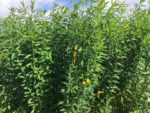The educational materials listed on this page are about Soil Quality/Health.
Farmers and ranchers use the term soil health to describe the condition of the soil. Scientists usually use the term soil quality, but both refer to the same idea — how good is the soil in its role of supporting the growth of high-yielding, high-quality, and healthy crops? Healthy soil generates higher crop yields, it absorbs and holds rainfall, and erosion is therefore reduced. The information here will show you how to improve soil fertility and build healthy soil. Two comprehensive books to consult are Building Soils for Better Crops and Managing Cover Crops Profitably.
Crop rotation, the use of diverse soil management practices, composting, and cover crops all contribute to healthy soil by conserving and building soil organic matter, absorbing rainfall, and retaining crop residues on the soil surface. Major conservation practices include conservation tillage, contour farming, strip cropping, terraces, diversions, and grassed waterways.
Soil consists of four parts: mineral solids, water, air, and soil organic matter. All four are important characteristics of fertile soil.
Soil organic matter consists of three parts: living organisms, fresh residues, and well-decomposed residues. The living part of soil organic matter includes a wide variety of microorganisms, such as bacteria, viruses, fungi, protozoa and algae. It includes plant roots as well as insects, earthworms, and larger animals in the soil. The fresh residues consist of recently deceased microorganisms, insects, earthworms, old plant roots, crop residues and recently added manures. This part of soil organic matter is the active, or easily decomposed, fraction. As soil organic matter is decomposed, many plant nutrients are released. The well-decomposed organic material in soil is called humus.The already well-decomposed humus is not a food for organisms, but its very small size and chemical properties make it an important part of a healthy soil. Humus holds on to some essential plant nutrients, storing them for slow release to plants. Good amounts of soil humus can both lessen drainage and compaction problems that occur in clay soils and improve water retention in sandy soils by enhancing aggregation, which reduces soil density, and by holding on to and releasing water.
The soil water, also called the soil solution, contains dissolved plant nutrients and is the main source of water for plants. Soil nutrients are made available to the roots of plants through the soil solution. The air in the soil provides roots with oxygen and helps remove excess carbon dioxide from respiring root cells. When mineral and organic particles clump together, soil aggregates are formed, resulting in a healthy soil with good soil structure and more spaces, or pores, for storing water.
Showing 1-2 of 2 results

Soil for Water
This series of 11 semi-structured interviews was carried out by Virginia Tech and Virginia Cooperative Extension to better understand farmers’ and ranchers’ agroecological motivations and values related to the protection and conservation of water resources. The series highlights diverse farms of Virginia’s agricultural community through a narrative inquiry framework. Introduction to the Soil for Water […]

Annual Cover Crops in Florida Vegetable Systems
Fact sheet series from the University of Florida IFAS Extension on integrating cover crops in vegetable production systems in Florida.